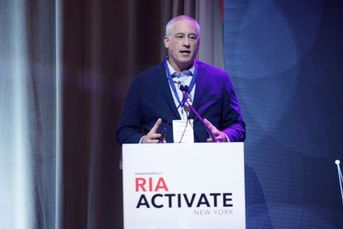As EV adoption races higher, is it time to charge into electricity investments?
 Brian Glenn of Premier Path Wealth Partners and Timothy Kramer of CNIC Funds
Brian Glenn of Premier Path Wealth Partners and Timothy Kramer of CNIC Funds
The three hottest investment areas over the past few years – crypto, AI and EVs – all require a ton of electricity.
Electricity is shaping up to be Wall Street’s next juicy investment space. The question facing financial advisors is how they intend to charge into it.
Crypto, AI and EVs have something in common other than being the three hottest investment areas over the past few years: They all require a ton of electricity, both to manufacture and maintain.
The Energy Information Administration estimates annual electricity use from cryptocurrency mining already represents from 0.6% to 2.3% of US consumption. The expectation on Wall Street is that this percentage will grow with increased cryptocurrency ownership, a trend that has been helped along by the spectacular price performance of bitcoin, as well as its recent availability via ETFs.
To exemplify this surge in power demand, the EIA points to the Lone Star State, where the Electric Reliability Council of Texas has 41 gigawatts of requests for new cryptocurrency mining capacity, for which only 9 GW of planning studies have been approved.
And it’s not just crypto creation that will be taxing America’s power grid going forward. AI and data center usage will also be stretching the capacity of the nation’s already-stretched power supply.
“Data centers took up about 2½ percent of the electricity in 2022, and they were projected to go up to as high as maybe 7 percent by 2030,” said Timothy Kramer CEO of CNIC Funds. “Well, in 2023 they were already 5 percent, so the forecasts are now saying that by 2030 you’re going to be somewhere between 10 to 30 percent of the entire electricity demand of the US is going to be for data centers.”
As for AI usage, Kramer says that right now a regular Google search takes about 0.3 watt hours of electricity, while an email takes around one watt hour and an AI search takes about four. However, he forecasts that could go as high as 15 watt hours as the amount of data and incorporation of AI increase in the next two to three years.
Last year, Kramer’s company introduced the CNIC ICE US Carbon Neutral Power Futures Index ETF (AMPD), which seeks to capitalize on the demand for power by using electricity and carbon allowance futures contracts to track the performance of the ICE US Carbon Neutral Power Index.
Stephen DeNichilo, senior portfolio manager at Federated Hermes, sees increased EV use as a substantial driver for electricity demand.
“I don’t know if 100 percent of our population is going to be driving EVs in the future, but it is probably going to be higher than the current level of about 5 percent if everybody plugs in their cars in at night,” he said.
DeNichilo is attempting to capitalize on this burgeoning trend by owning shares of a company called Quanta Services (PWR), which installs transmission and distribution lines.
“Our electrical grid is really made up of a bunch of smaller grids that are pieced together with Band-Aids and bandages. We were never meant to have one large contiguous electrical grid,” he said. “These are the guys that put it all together and make our energy system work.”
PICKING EV WINNERS
As for EV stocks, Brian Glenn, chief investment officer at Premier Path Wealth Partners, believes investors have confused first-mover advantage with sustainable competitive advantage.
“Tesla had that first-mover status and that fashion statement, but the company’s early success is working against them, naturally, and consumers want to wow their friends and neighbors with the next cool vehicle, which might be a Rivian or Lucid or Cadillac Lyriq. It’s much easier to change brands in automobiles than it is mobile phones,” he said.
Glenn sees hybrids serving as the bridge as drivers transition from internal combustion engine vehicles to EVs. And in his view, the longer the transition takes, the more advantaged legacy auto makers become, as they’re the ones that can do both in a single vehicle.
“They’re well capitalized, they have awesome distribution networks – dealers – to sell at scale, they each have several brands to test and iterate vehicle styles, and they’re throwing massive amounts of money at the problem,” Glenn said.
Christopher Davis, partner at Hudson Value Partners, is also not sold on Tesla dominating the future of EVs despite its early lead.
“The success of Tesla and the innovative genius of Elon Musk cannot be ignored, but in general the automobile business does not have the competitive dynamics we seek as investors,” Davis said. “Due to nonexistent switching costs for drivers, a low global market share needed to be viable, and high vulnerability to labor, materials, and shipping costs, automakers – even those with great brand value – don’t always translate into better than average returns for investors.”
Added Davis: “At this point in the market evolution, all carmakers are EV stocks.”
AI ‘super-cycle’ will power Dow above 100K in 10 years, says Main Street Research CIO
Learn more about reprints and licensing for this article.








